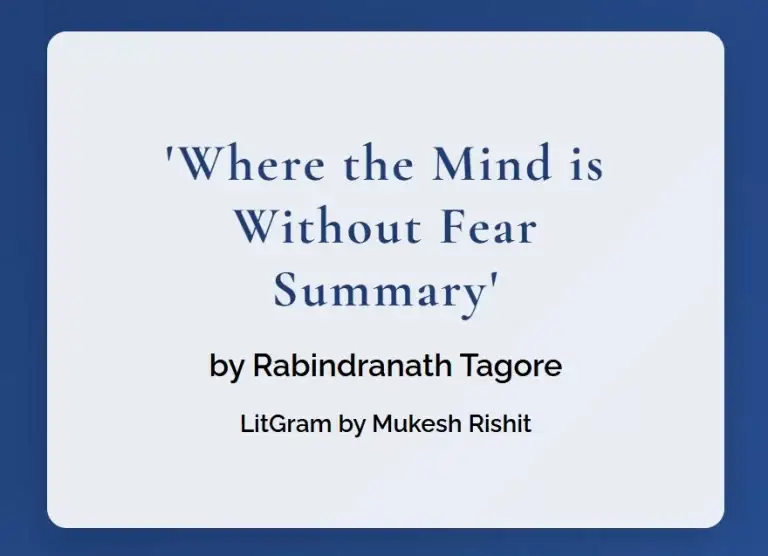“Where the Mind is Without Fear” is a moving poem by Nobel Prize winner Rabindranath Tagore. It paints a picture of a perfect world based on freedom, knowledge, and truth. If you want to know more about it, we’ll look at what the poem means how it’s put together, and why it matters. Let’s begin! Where the Mind is Without Fear Summary is specifically for 8th standard students.
Table of Contents
Summary of “Where the Mind is Without Fear”
Introduction
People long for freedom, and Tagore’s “Where the Mind is Without Fear” captures this feeling perfectly. This poem is part of his collection “Gitanjali” (Song Offerings), a group of 103 poems that brought him worldwide fame, including the Nobel Prize in Literature. In this poem, Tagore pictures a society where people can seek knowledge , share their ideas without fear, and coexist in peace and unity.
Stanza-by-Stanza Breakdown
- First Line: “Where the mind is without fear and the head is held high;”
- Tagore begins the poem with a strong picture of a mind free from fear and a head held high, which stands for self-respect and freedom from being held down.
- Second Line: “Where knowledge is free;”
- He pictures a world where everyone can get education and knowledge breaking down the walls of social and money-based differences.
- Third Line: “Where the world has not been broken up into fragments by narrow domestic walls;”
- Tagore speaks against splitting people up based on race, religion, and where they’re from. He wants a world that’s united and living in peace, beyond small fights.
- Fourth Line: “Where words come out from the depth of truth;”
- He wants a society where people are honest and speak from their core beliefs, without lying or trying to trick others.
- Fifth Line: “Where tireless striving stretches its arms towards perfection;”
- Tagore pictures a world where people keep working hard to get better and reach their full potential.
- Sixth Line: “Where the clear stream of reason has not lost its way into the dreary desert sand of dead habit;”
- He compares clear thinking to dry dull sands of old customs and strict traditions pushing for new ways of thinking.
- Seventh Line: “Where the mind is led forward by thee into ever-widening thought and action;”
- Tagore asks for divine help to broaden his ideas and actions going beyond limiting beliefs.
- Eighth Line: “Into that heaven of freedom, my Father, let my country awake.”
- He ends with a heartfelt plea to wake up his country India, to this imagined heaven of freedom signaling a new era of enlightenment and freedom. This shows Tagore’s deep desire for India to gain independence from colonial rule, which was still a dream when he wrote this poem.
Read this too: ‘Homecoming’ by Mukesh K Sharma: A Poignant Exploration of War’s Aftermath in the Midst of Celebration
Themes
- Freedom and Independence
- The poem centers on breaking free, both as a person and as a country. It shows Tagore’s hopes for an India no longer under British rule, and also calls for people to be free from fear and not knowing.
- Unity and Harmony
- Tagore highlights how important it is to stay together and speaks out against all ways society splits apart. He pictures a world where people live side by side in peace moving past narrow ideas of who they are and where they’re from.
- Knowledge and Truth
- The poem stresses the worth of knowledge that moves and can reach everyone, and going after what’s true. Tagore pushes for the freedom to think and learn as a must-have for a society that moves forward.
- Reason and Rationality
- A clear logical mind takes priority over following old traditions. Tagore’s push for reasoning shows his forward-thinking view and faith in what people can achieve.
- Keeping at It and Getting It Just Right
- Non-stop work to better oneself and grow the nation gets praise. Tagore’s perfect world doesn’t sit still but always aims higher.
Structure and Literary Devices
Form and Structure
- The poem uses free verse without a set rhyme pattern. This showcases freedom in its very form. The loose style helps create a thoughtful and uplifting mood.
Imagery and Metaphor
- Tagore paints word pictures and uses comparisons. He talks about “the clear stream of reason” and “the dreary desert sand of dead habit.” These make big ideas easy to grasp.
Personification
- Ideas like reason and knowledge become living things. This makes them seem more important and shows how much we want them in our world.
Alliteration and Parallelism
- The poem’s rhythmic quality and persuasive power get a boost from the use of alliteration (like “tireless striving stretches its arms”) and parallel structures.
To wrap up
“Where the Mind is Without Fear” goes beyond its time telling truths that apply everywhere about freedom, knowledge, and what people can achieve. Tagore’s deep vision still matters today pushing societies worldwide to seek truth, unity, and freedom of thought. This poem doesn’t just show Tagore’s ideal world; it also stands as a timeless call for people to work towards these high goals.
FAQs
1. What led Rabindranath Tagore to write “Where the Mind is Without Fear”?
- Tagore’s vision of a free and enlightened India, no longer under British rule and without social divisions, drove his work. He championed universal ideals of liberty, learning, and togetherness.
2. What is the main theme of the poem?
- The poem’s central idea is the dream of a world where liberty, learning, truth, and reason reign bringing people together and spurring ongoing personal growth.
3. How does the poem reflect Tagore’s hope for India?
- The poem shows Tagore’s wish for India to gain independence and become a country where all can live without fear, have access to education, and speak the truth.
4. What literary devices does Tagore use in the poem?
- Tagore paints a vivid picture through his words using comparisons, giving human traits to objects repeating sounds, and drawing parallels to get his message across in a way that sticks with readers.
5. Why does “Where the Mind is Without Fear” still matter today?
- The poem’s plea for liberty, honesty, togetherness, and clear thinking strikes a chord with people everywhere. This makes it just as important now as it was then in places where people still fight for and value these ideals.
Where the Mind is Without Fear Summary in Hindi
चलो दोस्तों, आज हम बात करेंगे रबीन्द्रनाथ टैगोर जी की एक बहुत ही खूबसूरत कविता के बारे में। इस कविता का नाम है “जहाँ मन भय-मुक्त हो” या अंग्रेजी में “Where the Mind is Without Fear”। क्या आप जानते हैं कि इस कविता के लिए टैगोर जी को नोबेल पुरस्कार मिला था? वाह, कमाल है ना! तो आइए, इस कविता को समझते हैं।
सबसे पहले, यह कविता किस बारे में है? देखो, टैगोर जी ने इसमें एक ऐसी दुनिया की कल्पना की है जहाँ हर कोई आजाद हो, सब को ज्ञान मिले, और सच्चाई की कदर हो। चलो, अब इस कविता को लाइन-बाय-लाइन समझते हैं।
पहली लाइन में टैगोर जी कहते हैं – “जहाँ मन भय-मुक्त हो और सिर ऊँचा हो।” यानी, ऐसी दुनिया जहाँ कोई डरे नहीं और सब अपने आप पर गर्व करें।
दूसरी लाइन – “जहाँ ज्ञान मुक्त हो।” मतलब, सबको पढ़ने-लिखने का मौका मिले, चाहे वो अमीर हो या गरीब।
तीसरी लाइन में वो कहते हैं – “जहाँ दुनिया टुकड़ों में न बँटी हो।” यानी, धर्म, जाति, या देश के नाम पर लोग एक-दूसरे से अलग न हों।
चौथी लाइन – “जहाँ शब्द सच्चाई की गहराई से निकलें।” मतलब, लोग दिल से सच बोलें, झूठ या धोखा न हो।
पाँचवीं लाइन में टैगोर जी कहते हैं – “जहाँ थकाहीन प्रयास पूर्णता की ओर बढ़ता हो।” यानी, हर कोई अपने सपनों को पूरा करने के लिए मेहनत करता रहे।
छठी लाइन – “जहाँ तर्क की साफ धारा पुरानी रीतियों की रेत में न खो जाए।” मतलब, लोग पुरानी सोच में न फँसें, नए विचारों को अपनाएँ।
सातवीं लाइन में वो कहते हैं – “जहाँ तू मन को आगे बढ़ाए, नए विचारों और कार्यों की ओर।” यहाँ टैगोर जी ईश्वर से प्रार्थना कर रहे हैं कि वो हमें नए विचारों की ओर ले जाए।
और आखिरी लाइन – “हे पिता, मेरा देश ऐसी स्वतंत्रता के स्वर्ग में जागे।” यहाँ टैगोर जी चाहते हैं कि भारत आजाद हो और तरक्की करे।
अब सोचो दोस्तों, टैगोर जी ने यह कविता कब लिखी थी? जब भारत अंग्रेजों के राज में था। वो चाहते थे कि हमारा देश आजाद हो, यहाँ सबको पढ़ने का मौका मिले, लोग एक-दूसरे से प्यार से रहें, और हर कोई अपने सपने पूरे कर सके।
इस कविता में टैगोर जी ने कुछ खास बातें कही हैं:
- आजादी और स्वतंत्रता
- एकता और भाईचारा
- ज्ञान और सच्चाई की अहमियत
- तर्क और बुद्धि का इस्तेमाल
- लगातार मेहनत और सुधार
क्या आप जानते हैं, यह कविता आज भी उतनी ही जरूरी है जितनी पहले थी? क्योंकि आज भी दुनिया के कई हिस्सों में लोग आजादी, शिक्षा, और सच्चाई के लिए लड़ रहे हैं।
तो दोस्तों, अगली बार जब आप यह कविता पढ़ें, तो सोचिएगा कि आप अपने आस-पास की दुनिया को कैसे बेहतर बना सकते हैं। क्योंकि टैगोर जी का सपना सिर्फ भारत के लिए नहीं, पूरी दुनिया के लिए था।
क्या आपको यह कविता पसंद आई? इसमें से कौन सी बात आपको सबसे ज्यादा अच्छी लगी? अपने दोस्तों और टीचर से इस बारे में जरूर बात कीजिए। याद रखिए, जब हम मिलकर सोचेंगे और काम करेंगे, तभी हम एक बेहतर दुनिया बना पाएंगे!



1 Comment
Pingback: Rabindranath Tagore: Life, Works, and Legacy for RPSC Second Grade